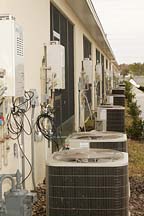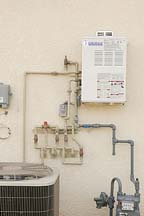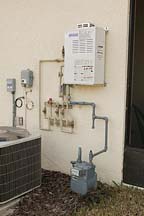
Front elevations of single-family homes at Trafalgar Village in Poinciana, Florida, near Orlando.
When the developer of Trafalgar Village in Poinciana, FL, began planning a short-term vacation rental neighborhood community with 229 single-family homes, 71 townhouses and 140 apartments, the company saw plenty of "green"

Outdoor installation of Takagi T-K1S units at Trafalgar Village
Then Trafalgar Enterprises learned about the energy efficiency of natural gas from TECO Peoples Gas, the local gas utility, and John Snyder of Allard Product Resources in Oldsmar, FL. Allard is an independent manufacturers representative that specializes in energy-saving products, including Takagi tankless water heaters.
"Going with natural gas would offer the developer lower operating utility costs and higher efficiency,"

Outdoor installation of Takagi T-K1S units at Trafalgar Village
Oversized Furnaces: Far From Green
Florida's tropical weather may sound like paradise to homeowners in colder climates that complain that their heating bills are breaking the household budget while they shiver through the winter months. Yet even Florida residents have a complaint with their heating systems: They are built for cold-weather climates. The alternatives are electric heat pumps, which are not warm enough; and electric heat strips, which are warm, but too expensive to operate. The Southern states are generally an air-conditioning market. Typically, the heating load for a dwelling is low, while the cooling load is high. When selecting an air-conditioning system that can match the latter, homeowners must also purchase a furnace that is usually made to accommodate the maximum heating load of a colder climate. As a result, many consumers in moderate-to-warm climates are saddled with oversized furnaces that overheat their homes. Residents end up paying for a furnace that far exceeds their needs. This is not exactly green thinking.
Outdoor installation of Takagi T-K1S units at Trafalgar Village
Dual-Powered Solution
To solve this problem, Snyder proposed that Trafalgar Enterprises consider a dual-purpose tankless water heater system that could provide hot water for washing and cleaning as well as for heating for the home's interior, as needed. Instead of continuously heating water in a storage tank-24 hours a day, seven days a week-a tankless Takagi unit heats water only on demand; that is, only when the consumer needs it. As long as a faucet, shower or hot water appliance is operating, the tankless water heater continues to run. Once the faucet or appliance is turned off, the tankless unit stops.This on-demand approach made a lot of sense, since Trafalgar Village was planned as a short-term vacation rental community whose residences could stand vacant for weeks at a time. Why spend money needlessly heating water no one would use?
Equally as important, the Takagi Flash T-K1S heaters installed at Trafalgar Village provide not only potable hot water for a single-family house with three full bathrooms, but also, as noted, all the hot water needed for hydronic heating in these residences.
"Each Takagi heater provides hot water that is also circulated through a heating coil for space heating,"
Tankless: Nothing New
"Tankless water heating was nothing new to us, because this technology has been available in the United Kingdom for 25 years,"
Rear of townhomes at Trafalgar Village where tankless water heaters were installed, saving critical space inside these residences.